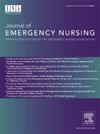确定急诊科医护人员及其相关职业倦怠和创伤后应激障碍评分之间的相关性:试点研究。
IF 1.8
4区 医学
Q2 EMERGENCY MEDICINE
引用次数: 0
摘要
引言医护人员所处的环境可能会导致职业倦怠和创伤后应激障碍。尽管研究有限,但及早识别有职业倦怠/创伤后应激障碍风险的医护人员可以更快地实施缓解策略。本试验性研究探讨了医护人员的职业倦怠和创伤后应激障碍与人口和职业因素之间的关联:这项关于职业倦怠和创伤后应激障碍的横断面定量研究于 2022 年至 2023 年在一个单一地点的城市学术急诊科进行。为保密起见,医护人员分为医护人员和非医护人员。倦怠和创伤后应激障碍采用奥登堡倦怠量表和创伤后应激障碍核对表进行测量:在这一群体(n = 72)中,许多人被认定为非西班牙裔白人(54%)、女性(74%)、每周工作 32-40 小时的非医务人员(75%)。非医务人员的离职率较高(14.8% 对 0%,P = 0.19),但差异不大。女性的疲惫程度更高(64.2% 对 57.9%,P = .63),而男性的脱离程度更高(15.8% 对 9.4%,P = .43)。与会者讨论:尽管这些结果在统计学上并不显著,但我们证明了与临床相关的重要关联。40 岁以下的非医务人员表现出更高的脱离感,这可能与相互竞争的责任有关,而抑郁则增加了所有领域的职业倦怠严重程度。重要的是,未来的研究将增加样本数量,以便进行相关的亚组比较(即护士与其他非医务人员),并继续探索影响医护人员职业倦怠程度升高的因素。本文章由计算机程序翻译,如有差异,请以英文原文为准。
Determining Correlations Between Emergency Department Health Care Workers and their Associated Burnout and Post-Traumatic Stress Disorder Scores: A Pilot Study
Introduction
Health care workers experience settings that can contribute to burnout and post-traumatic stress disorder. Early identification of health care workers at risk for burnout/post-traumatic stress disorder may allow for quicker implementation of mitigation strategies despite limited research. This pilot study explores associations between burnout and post-traumatic stress disorder with demographic and occupational factors in health care workers.
Methods
This quantitative, cross-sectional study on burnout and post-traumatic stress disorder was conducted at a single-site urban academic emergency department from 2022 to 2023. Health care workers were split into provider versus non-provider for confidentiality. Burnout and post-traumatic stress disorder were operationalized using the Oldenburg Burnout Inventory and Post-Traumatic Stress Disorder checklist.
Results
In this cohort (n = 72), many identified as non-Hispanic white (54%) females (74%), and were non-providers (75%) who worked 32 to 40 hours/week (75%). Although not significant, non-providers reported higher disengagement (14.8% vs 0%, P = .19). Females had higher exhaustion (64.2% vs 57.9%, P = .63) while males had higher disengagement (15.8% vs 9.4%, P = .43). Participants <40 had higher disengagement and exhaustion (15.8% vs 5.9%, P = .27; 68.4% vs 55.9%, P = .27), while a previous depression diagnosis led to increased moderate-to-severe disengagement, exhaustion, and burnout (26.7% vs 6.9%, P = .05; 80.0% vs 56.9%, P = .14; and 53.3% vs 37.9%, P = .28, respectively).
Discussion
Though these results are not statistically significant, we demonstrate important associations that are clinically relevant. Non-providers under 40 showed higher disengagement, which may be related to competing responsibilities, while depression increased burnout severity across all domains. Importantly, future research with increased samples will allow relevant sub-group comparisons (ie, nurses vs other non-providers) and continued exploration of factors that influence elevated burnout in health care workers.
求助全文
通过发布文献求助,成功后即可免费获取论文全文。
去求助
来源期刊
CiteScore
3.10
自引率
11.80%
发文量
132
审稿时长
46 days
期刊介绍:
The Journal of Emergency Nursing, the official journal of the Emergency Nurses Association (ENA), is committed to the dissemination of high quality, peer-reviewed manuscripts relevant to all areas of emergency nursing practice across the lifespan. Journal content includes clinical topics, integrative or systematic literature reviews, research, and practice improvement initiatives that provide emergency nurses globally with implications for translation of new knowledge into practice.
The Journal also includes focused sections such as case studies, pharmacology/toxicology, injury prevention, trauma, triage, quality and safety, pediatrics and geriatrics.
The Journal aims to mirror the goal of ENA to promote: community, governance and leadership, knowledge, quality and safety, and advocacy.

 求助内容:
求助内容: 应助结果提醒方式:
应助结果提醒方式:


